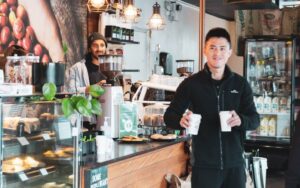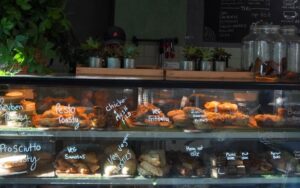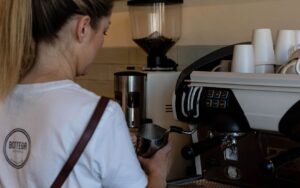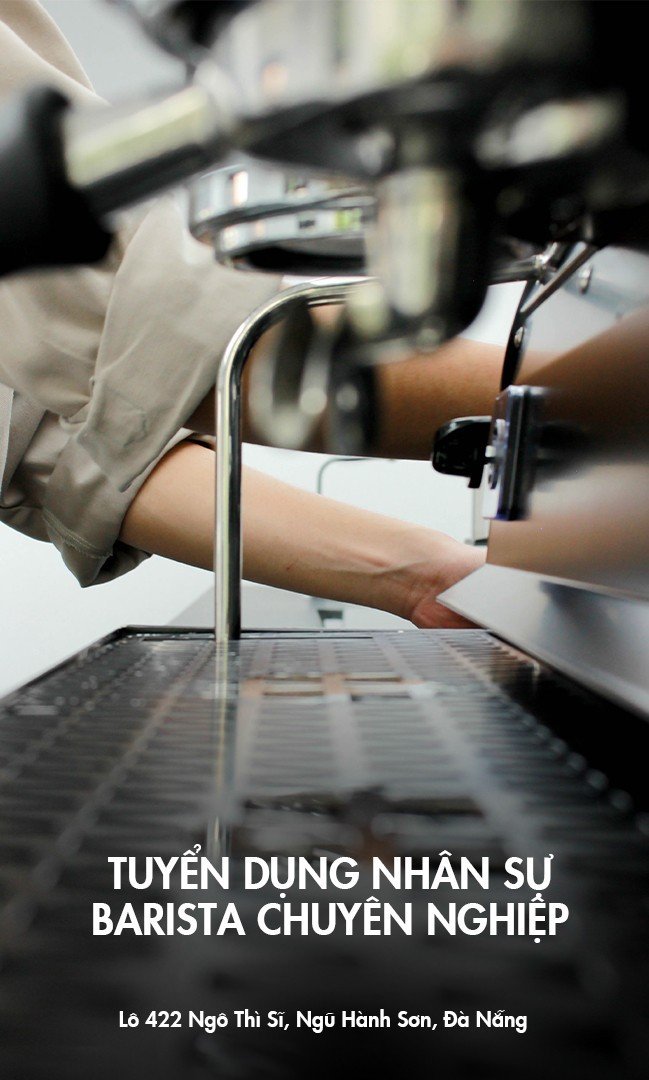Service and hospitality:
Breaking down coffee’s
customer experience
Why do customers keep going back to one particular coffee shop when they have dozens to choose from? For some, it might be the quality of the coffee they drink; for others, it might be a case of affordability. However, for many coffee consumers, the decision is grounded in the service that they receive.
Experience is a key part of specialty coffee. It has a huge impact on whether or not a customer will want to keep coming back.
But across the hospitality sector, in coffee shops and beyond, there is a growing and recognisable difference between being provided a service and having a truly “hospitable” experience.
To learn more about how the two are different, I spoke to two coffee professionals in London. Read on to find out what they said, and to learn more about how cafés can deliver both.
HOW ARE SERVICE AND HOSPITALITY DIFFERENT?
Offering a service means providing people with something they need. In contrast, hospitality derives from the Latin word hospitalitat: the act of entertaining guests.
While the former involves offering the minimum, the latter means going above and beyond to give the customer you’re serving a reason to keep coming back.
And while it’s well-known across the hospitality sector that you can’t please everyone all the time, that doesn’t mean you shouldn’t try.
To learn more, I spoke with Peter Dore-Smith, the founder and Director of Kaffeine. Kaffeine is a two-store specialty coffee shop chain based on and around Oxford Street in London – one of the busiest roads in the UK in terms of consumer footfall.
Peter tells me that his philosophy is simple: a customer should feel better leaving his café than they did entering it.
He’s adds that he has trained his staff to recognise the “human element” of serving customers. For example, when a person enters their front door, baristas should realise that they’re bringing their whole day with them.
“You go to the bank and it’s miserable. You go to the supermarket and it’s miserable,” he says. “When we opened, I told staff that people must feel welcomed when they enter our café.”
For customers, visiting a specialty coffee shop is more than just stopping for a drink; it’s an experience. After all, you could enjoy a cup of quality coffee at home. A morning visit to a coffee shop can set you up for the day to come, or help you prepare for a challenging meeting.
“It’s hard out there for people,” Peter says. “They need a space where they can refresh themselves before returning to their worlds. We can help them do this by being hospitable.”

THE RIGHT SERVICE
Part of understanding the difference between hospitality and service is realising where each is needed.
Customers looking to linger, read a book, and drink a latte might appreciate a conversation and a little more attention, but those after a quick coffee on their morning commute might not.
This raises an important question: should customers expect a high level of hospitality every time they visit a coffee shop?
Damiano Archetti is the head barista of Omotesando Koffee’s London location. He says that it can be challenging to balance quick service and hospitality in small locations, especially those that experience high volumes of foot traffic.
“When a place gets really busy, sometimes service and speed have to be prioritised,” he explains. “[Most] customers will understand that this means slightly less hospitality.”
Damiano adds that it’s important to differentiate between the needs of weekday and weekend customers.
Weekday sales, he says, are dominated by office workers who value speed and efficiency, as Omotesando’s London location is near a large number of office buildings.
In contrast, at weekends, he says he sees more tourists. In this case, customers are more likely to appreciate being able to take their time and ask questions.
The key to getting your approach right, Damiano says, is finding out what people are looking for. “I try to understand what each customer wants as quickly as possible,” he says.

HOSPITALITY: THE SAME IN ANY LANGUAGE?
Visit coffee shops around the world and you’ll find that the definition of “good service” varies from country to country.
However, coffee shop owners should interpret this in another way. If you want to appeal to as many people as possible, then design your customer experience to transcend language barriers and cultural norms.
Lauren Smith is a badminton player who represented the United Kingdom at the 2016 Olympics in Rio de Janeiro. As a specialty coffee fan who attends tournaments around the world, she believes there are a few key touches that always make for a hospitable experience.
She says: “We were in Mexico City and visited a little café near our hotel. I got to know the staff in a few days.
“When I walked in they would greet me by name and I developed a rapport with them. It was comforting.”
Peter provides another example. He says that he started his career in Australia before moving to the UK. He notes that people have a fundamentally different relationship with specialty coffee in the two countries.
“[What I define as] hospitality has been going a lot longer in Australia than it has in the UK,” he explains.
“In Australia, going out for a coffee is a common activity that you enjoy with family and friends. It’s a more relaxed lifestyle.”

In contrast, Damiano says he started his career in Italy. He tells me that he found his “professional” approach was actually viewed as rude by a lot of his customers.
By focusing on getting orders out quickly and turning tables over to make sure they were ready for arriving guests, he says didn’t have time to joke and chat with customers.
However, he says his attitude changed again when he moved to London. After serving people from all around the world, he realised that there wasn’t a single “perfect” approach.
“Finding [out] how to be yourself in the place where you are is key,” he says.
For Omotesando, he said adapting to the definition of “good service” didn’t just trickle down to each barista, but how the business operated.
He explains that when the chain opened its London branch (the first location outside of Japan), customers expected loyalty schemes, which are commonplace among coffee shops in the UK. However, Damiano tells me that Omotesando’s Japanese owners felt a loyalty scheme would cheapen their approach.
“I had to explain to [customers] that we want to sell a prime product and that service is part of it,” he adds.

“THE ONE PERCENTS”
Some coffee shops will have a “signature” act of hospitality. This can become a trademark of sorts; a customer service touch that coffee drinkers won’t often find elsewhere.
This might be subtle, like serving customers water with their coffee by default, or playing a particular genre of music that is audible without drowning out the conversation.
As an example, at Omotesando, Damiano says a host always greets customers upon entry. While this is a common custom in the Japanese hospitality sector, it is rare in the UK.
Peter refers to these small but significant touches as the “one percents”.
He gives me an example. In a Kaffeine store, he says that one day, a barista started making left-handed flat whites for left-handed customers.
He says that it wasn’t something that was taught to the baristas by default. Instead, it came about organically, and came to be a unique way of enhancing the customer’s experience.
“That’s hospitality,” he tells me. “That’s looking after people and making them feel special.”

PLAN FOR POSITIVE CUSTOMER EXPERIENCES
These “one percents” and your full hospitality strategy might take a while to develop. However, even in the early stages, there’s a lot you can do to improve how hospitable your coffee shop is. Some of this, Peter adds, you can even achieve before opening a new location.
For example, Peter says that he planned his second café around the customer experience he wanted to provide. He chose a location on a quiet one-way street to minimise traffic and noise.
He also made sure that his coffee shop had south-facing front windows to ensure there was always a lot of natural light – as well as a good view.
However, for any well-rounded hospitality experience, one thing you can’t underestimate is the importance of good, well-trained staff. For Damiano, the key is finding people who are the right fit for your business.
“Staff are your biggest asset,” he says. “Taking time to recruit, train, and support them will improve the customer experience.”
Peter agrees, noting that your staff members are “front-facing” all the time. He says that this means they’re always representing you and your business.

Understanding the difference between hospitality and service can be a great first step towards attracting and retaining more customers. Peter even says that it’s more important than the coffee you serve.
Damiano agrees, but notes that there should be a balance. “If you have a good product, you should have a high level of service,” he says. “Hospitality and speciality coffee go hand in hand.”
As a customer, Lauren says that she appreciates great service. However, she notes that she needs more than that to become a regular. “Service is putting the effort in to make it somewhere you want to spend your afternoon,” she tells me. “If I was going to be a regular, I would have to have both.”
The key to success, according to these interviewees, is finding a balance between the two: serve great coffee while also making your customers feel at home. And in good time, you’ll be able to tell just how successful your approach has been.
Source: Perfect Daily Grind
Link:https://perfectdailygrind.com/2021/02/service-vs-hospitality-breaking-down-coffees-customer-experience/








